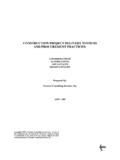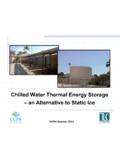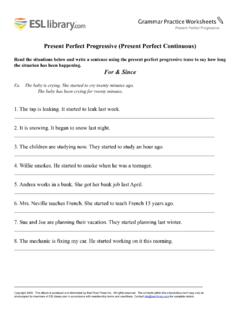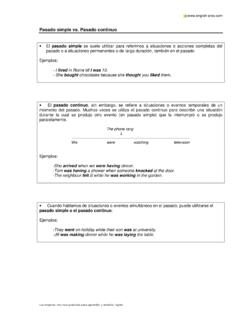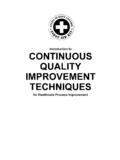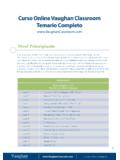Transcription of Welcome [www.fefpa.org]
1 Welcome CARPET101 & The Commercial Specification IIDA Course No. 4328 AIA Course No. 00M-99 Objectives CARPET101 This educational forum outlines criteria to be examined in achieving carpet specifications that meet aesthetic and performance expectations. The course will give an overview of fibers, yarns, dyeing, backings and related manufacturing processes. Carpet construction will be reviewed including woven and tufted. Objectives CARPET101 The professional will gain a balanced and generic understanding of specific construction criteria in carpet specifications including fiber types, dye methods, gauge, weight, etc. Factors will be evaluated for comparing products submitted as ..or equals on a project. Inclusions in the specifications address specific expectations with regard to performance.
2 Elements of a Good Carpet Construction CARPET101 Fiber Yarn Formation Fabric Formation Dyeing Method Special Treatments Backing System Elements of a Good Performance Specification CARPET101 Fiber Yarn Formation Fabric Formation Dyeing Method Special Treatments Backing System Factors in Constructing & Specifying Carpet CARPET101 Aesthetics: Color, design, texture, visual appeal Appearance: Durability, colorfastness, texture or appearance retention, stability and cleanability Performance: Flammability, acoustical value, indoor air quality, static propensity, anti-microbial, anti-stain and anti-soil properties Budget: Cost, installation, maintenance, life cycle Government or Building Code Requirements Sifting through the Maze CARPET101 Construction details What types of constructions should be used?
3 Construction vs. Performance: which wins? What Elements should a Construction Spec. Contain? How does construction affect performance? Which Spec. component(s) is/are most important? How tight should a specification be? or Equal defined: Performance or Construction? Apples to Apples Comparisons The Role of Density in a Specification Traps to Avoid Test Methods Construction Language CARPET101 Gauge/Pitch & Stitches/Rows Gauge/Pitch CARPET101 Tufted - The spacing between needles across the width of the machine is called gauge. In an 1/8 gauge product, the needles are 1/8 apart, resulting in widthwise density of 8 ends per inch. Stitches/Rows CARPET101 Tufted Products - The lengthwise number of tufts is called stitches. Stitches per inch determine the lengthwise density of tufts.
4 Construction Types CARPET101 Tufting & Weaving Weaving Process CARPET101 History records that weaving is one of the oldest art forms tracing back to 5000 BC. Woven floor coverings were first made as early as the 14th century. Woven Interlace Concept CARPET101 Tufting Process CARPET101 Yarns are pushed through a primary backing with needles. Holes are punched through a thin 3oz. Primary sheet. More holes are punched as more weight and density are needed. Fibers CARPET101 Nylon 6 - Caprolactam Fibers CARPET101 Nylon - Hexamethylene Diamine & Adipic Acid Fibers - Characteristics of Each Fiber CARPET101 Nylon 6 Accepts Color Well 100% Recyclable into virgin Nylon Infinitely Post Consumer content Gaining Market Share Nylon Difficult to Re-process Polymer Not recyclable into virgin Nylon Post Industrial content Only at the present time.
5 Losing Market Share Yarn Formation Elements of a Good Construction Specification CARPET101 Fiber State by Manufacturer and Type Yarn Approximate yarn Size Number of Piles (2, 3, 4, etc.) Yarn Process Air Entangled Twisted Only Twisted and Heatset Any Hybrid Dye Methods Elements of a Good Construction Specification CARPET101 Piece dye Beck Continuous Yarn dye Skein Space Solution dye Fiber Combinations Skein/Solution Solution/Space Etc. Fabric Formation Systems Woven and Tufted CARPET101 WOVEN LOOM TYPES Axminster Cut Wilton Complex Pattern Loop - Cut - Cut/Loop Dobby simple Pattern Loop - Cut - Cut/Loop 1,2,3,4 Heddle Color No. Loop - Cut - Cut/Loop Interlock Loop TUFTED Broadloom Loop - Cut - Cut/Loop Patterning Devices Yarn-side to side Yarn-up and down Modular Loop - Cut - Cut/Loop Patterning Same Fabric Formation Elements of a Good Construction Specification CARPET101 Type Tufted or Woven Broadloom or Modular Texture Cut or Uncut Tip Shear Textured or Level Pattern or Non Pattern Gauge or Pitch Give two alternatives - 1/8 or 1/10 If very fine construction - 1/12 or 5/64 Woven is more specific Acceptable Commercial Gauges CARPET101 WOVEN From Non pattern to sophisticated Axminster Patterns Gauges 135 pitch 165 pitch 216 pitch 270 pitch Since the original woven carpets were 27 inches wide, the widthwise density is called pitch.
6 And is stated as the number of ends across 27 inches of width. TUFTED From Non pattern to sophisticated Single end Pattern control Gauges 1/8 gauge 1/10 gauge 1/12 gauge 5/64 gauge 1/16 gauge Backing Systems Elements of a Good Construction Specification CARPET101 Standard Secondary Sometimes known as ActionBac Standard Performance Unitaries With or without Secondary Performance Laminate Systems High performance Characteristics Performance Cushion Systems High performance Characteristics Modular Systems Cushion or Hardback High Performance Treatments & Special Chemistries Elements of a Good Construction Specification CARPET101 Stain Resist Generic Special Built-In Soil Resist General Specific Antimicrobial Other Specialized Which Construction Systems Should Be Used? CARPET101 All CAN Perform Well Minimum Standards must be used All factors must be weighed Depends on 2 Main Factors Type of Application Type and amount of Traffic How Should Construction Specifications Be Used?
7 CARPET101 As a means of achieving desired performance and Aesthetic Objectives. It should be the Outcome of the Performance Criteria It should be the Outcome of the Aesthetic needs. It is a By-product of the flooring budget They are a means of obtaining the best flooring solutions for every End use. Construction vs. Performance: Which Wins CARPET101 Neither They are Totally Interrelated Performance should be the overriding factor But, Performance must be blended with Aesthetic considerations: Color, Texture, Pattern Construction vs. Performance: Which Wins CARPET101 Performance Rigid Design/Aesthetics Flexible Final Product Rigid & Flexible Components Meet all Criteria How Does Construction Affect Performance CARPET101 Construction Largely determines performance Construction consists of many facets: Each play a role Fiber Yarn Dyeing Fabric Formation Backing Systems Treatments Which Construction Components are Most Important CARPET101 They are all Important Each Component acts as a piece of the puzzle All pieces of the puzzle must mesh to complete the picture Yarn sizes correlate with gauge Dye methods consistent w/application Dye technique consistent w/end use Backing systems appropriate w/performance How Tight should a Spec.
8 Be CARPET101 Specific enough to achieve the desired performance requirements, but general enough to allow for the manufacturers to use the most effective technology to meet the needs of the project. Some items can be a little more general Yarn size range Gauge range Pattern size range Some items can be very specific Texture type Twisted or Entangled yarns Key is to allow for the best choice from the manufacturer s technology to achieve the Client s needs Or Equal Defined Construction or Performance CARPET101 One of the most misunderstood and confusingly used term in Specifications Equal is defined by the specifier What items must be same Pattern, Color, Liquid Barrier What items can vary Gauge, Fabric formation, dye technique PERFORMANCE rules, and should be equal with any competitive product Aesthetics should be closely duplicated in an equal Construction parameters should be secondary to achieve Performance and Aesthetic specifications Or Equal Stands the Legal Test CARPET101 Federal Courts have ruled that Proprietary Specifications are not a violation of Antitrust Specifiers make informed judgments on products which they feel best serves their clients needs.
9 Or Equals actually enhance competition and opens up projects to a wider array of choices among similar products. How is Specifier Protected from Liability CARPET101 SPECIFICATION DOCUMENT It is the only document that protects the specifier with regard to quality of material and proper installation. Apples to Apples Comparison CARPET101 All components of specifications should be the same if they are truly to be equals Fiber - Nylon Twisted vs. Twisted; not Twisted vs. Air Entangled Solution vs. Solution; not Solution vs. Space or piece Cushion vs. Cushion; not Cushion vs. Laminate Tufted vs. Tufted; not Tufted vs. Woven These are important for pricing/Budget purposes as well as performance purposes Role of Density CARPET101 Important Indicator of relative fabric integrity, but only one component of total performance picture Average Pile yarn Density Specify minimum, not an absolute number Minimum should be around 5000 Weight x 36/pile thickness Traps to Avoid CARPET101 The most common trap on many specifications is the reliance on one single factor of a construction specification by which the entire acceptance of a product is justified.
10 Accepting only density Accepting only gauge Accepting only one yarn size Any other single construction parameter Test Methods: Assurance of Quality CARPET101 Appearance Retention CRI TM 101 (Hexapod) Static Rating AATCC 134 (less KV) IAQ (GLP) ASTM D5116 Flammability ASTM E 648 (Radiant Panel) NBS Smoke ASTM E 662 Tuft Bind ASTM D 1335 Delamination ASTM D 3936 Dimensional Stability ISO 2551 Colorfastness (light) AATCC 16-E Colorfastness (ozone) AATCC 129 Fastness (crocking) AATCC 165 Water Bleed AATCC 107 Soil Resistance CRI TM 102 Stain Resistance AATCC 175 Other Specialty British Spill Barrier Test Bleach Antimicrobial Thank You Questions

